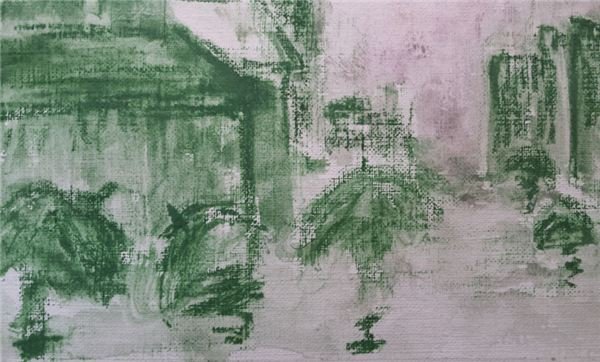Rainy Day in the City; High School Art Class Lesson Plan
Objective
Students will design and paint a spring scene featuring umbrellas and bright reflections of rain.
Materials
-
Reference photos and art samples
-
Colored pencils
-
Painting knives or flat brushes
-
Bright colored paints (the thicker the better)
-
Watercolor or ink
-
Watercolor brushes and water
-
Watercolor paper or flat canvas
-
Paint boards and tape (if using paper as a surface)
-
Paper towels
Lesson Procedure
Step One:
Introduce students to examples of painted rainy scenes featuring prominent umbrella shapes, bright colors, and reflected water. (Links to possible samples are listed at the end of the article.)
Guide students in identifying common elements of rainy scene art, such as large, rounded umbrella shapes, vertical patterns to simulate rain, and horizontal brush strokes that create reflective water with lights and shadows.
Step Two:
Ask students to create their own spring rain scene, first sketching out a plan for big shapes. Students may wish to incorporate large shapes such as boxes for buildings, half-spheres for umbrellas and vertical figures and forms, such as people and light posts or signs. Instruct students to sketch in basic lights and darks and create a simple color scheme using colored pencils, focusing lights and shadows on reflective water and emphasizing umbrellas with bright colors.
Step Three:
Direct the students to fill in their drawings lightly on taped-down paper or flat canvas using watercolor paints and brushes. Students will block in lights and darks using neutral and dark colors at this stage. Once the painting is lightly blocked in, students should focus on the sky, adding darks for clouds and shadows and lifting out lights with paper towels. Once students are satisfied with the sky, they should set the paintings aside to dry completely.
After the paintings have dried, students can work with thicker paints to create a loose, energized painting, adding bright colors to umbrellas and using horizontal strokes to depict highlights and colors in the reflected water on the street. At this stage, students should use large brush or knife strokes and focus on working the overall painting at once, in order to maintain the energized feel of a rainy spring day in the city. Remind students to maintain their lights and darks and to focus on big shapes rather than worry about small details at this stage. Reflections on the wet ground should be mirror images of objects above them and should carry some of the colors of the sky and umbrellas. Students will need to allow ample time for paintings to dry because of the thickly applied paint.
Spring Rain Wash
After paintings have dried, students may want to use smaller brushes to add a few random details. Remind students that people are likely moving quickly to get out of the rain, so figures should appear to be on the move. Flowing hair and clothes, angled limbs, and bent posture are good ways to show that people are hurrying to move along in the rain.
Spring Rain
Assessment
Students will share their paintings with the class and identify common characteristics that express the energy of spring rain in the city to the viewer.
Extension
For a challenge, offer students the opportunity to paint a rainy country scene to contrast their rainy cityscapes.
Resources
Links to possible samples:
Eugenio Lucas Villaamil Leaving the Bullring Rain
